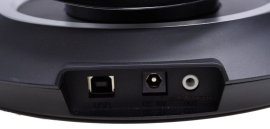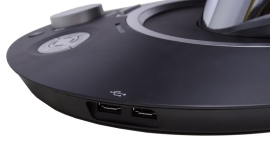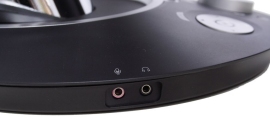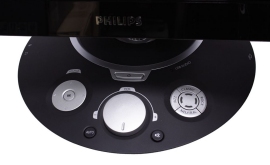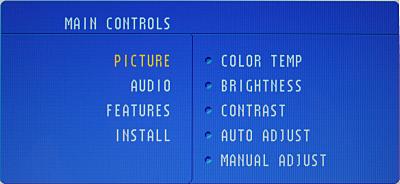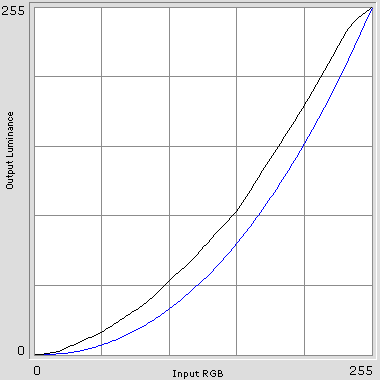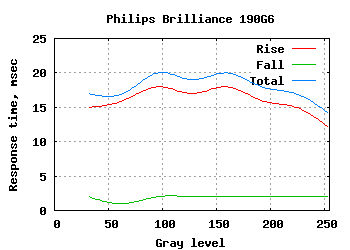LCD MONITOR REVIEW PHILIPS BRILLIANCE 190G6 19 INCH
![]()
|
|
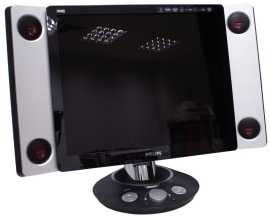 |
||||||||||||
| Posted:2006-07-08 By lcd monitor Number of View:97245 |
|||||||||||||
By :lcd monitor Posted:2006-07-08
Philips Brilliance 190G6
It’s no use to describe this lcd monitor – you must see it for real. Philips came up with something that’s not a PC lcd monitor proper, but a sort of a home multimedia system. The product you take out of a huge box is bigger than many lcd monitors with a larger screen diagonal. There are four speakers on the sides of the 190G6 which are also quite large as lcd monitors’ speakers go. You say that even these large speakers are no good at reproducing a really deep bass? Well, there is a separate subwoofer for that in the package:
And that’s not the most thrilling feature, either. The biggest surprise is that the lcd monitor sports its own audio card with a USB interface for the computer. I confess I haven’t seen anything like that before!
This thing cannot be described as “compact” if viewed from a side. There’s a kind of a cup behind each speaker which are in fact speaker enclosures. As you know, a speaker sounds bad by itself and needs an acoustic enclosure, a closed volume. Here, this volume is quite big while keeping the lcd monitor relatively thin. The stand allows changing the tilt of the screen only. And it is quite unnecessarily chrome-plated. Shiny lcd monitors look splendid on a shop shelf, but all this excessive gloss and shine will only be distracting at real use.
The lcd monitor has a full set of video connectors. At the back and bottom there are analog and digital inputs, an audio connector (in addition to the integrated audio card), SCART and S-Video connectors. This all can be hidden with a black cover after you’ve attached all the cables.
Two more groups of video connectors are located on the side: a composite input (labeled CVBS) with its accompanying audio input, and a component input (labeled HDTV) with a couple of its own audio connectors. I’d want to remind you that there are two standard resolutions in HDTV, 720 and 1080 lines (which split further in twos by the type of line scanning, but it doesn’t matter here). The 1080 lines mode is considered the basic one. Like a standard 19” lcd monitor, the 190G6 has a native resolution of 1280x1024 or 56 lines less than in a HDTV frame.
The base is rigged up well, too. There are three more connectors on its back: power (the lcd monitor’s got an external power supply), a USB input for the audio card and for the integrated USB hub, and an audio output for the subwoofer.
You will find the mentioned hub on the left of the base. It gives you two more USB ports.
On the left of the base, there are also two audio sockets: microphone input and headphones output. This seems to be all. I hope I haven’t missed any of the lcd monitor’s numerous connectors :).
The top of the base has an impressive appearance, too. It’s here that the lcd monitor’s controls are located. To my mind, the lcd monitor offers even too many of controls. A sound volume control is placed in the middle. It is not a variable resistor, but a so-called encoder. An encoder works like the ball of a computer mouse: it sends the controller the number of impulses proportional to the angle of turning. Unlike a variable resistor, an encoder has no limits – you can turn it around as long as you want to. Encoders have come to be used extensively in home appliances due to the need of synchronization between the various controls. For example, a music box allows changing the sound volume with a knob on the box itself or with a remote control button. Suppose you’ve selected a certain sound level with the knob and are now adjusting it with the remote control – the hairline on the knob now points to a wrong volume value! The problem can be solved by implementing an electromechanical drive in the knob so that when you are pressing down on a remote control button, an electromotor is activated in the device to turn the knob around by the necessary angle. This solution looks cool, but is rather costly and difficult to implement (this is mechanics, after all). The encoder is a simpler solution to the same problem. Since it doesn’t have a limiting position, you just don’t gauge it and that’s all. When you change the sound volume from the remote control, the electronics remembers it. And then if you begin to turn the encoder’s knob around, the electronics detracts from (or adds to) the sound volume value according to the impulses produced by the encoder. Well, you may say there is a hairline on the encoder in the snapshot above. Yes, it’s there, but only for the sake of beauty. The direction this hairline points to means absolutely nothing (by the way, this is the single drawback of an encoder – the position of its knob doesn’t tell you the current sound volume level. That’s why it is usually not gauged at all). You can check this out yourself: set a certain volume on the lcd monitor, turn it off, turn the encoder’s knob around how you like (you can even make several rounds, if you wish), turn the lcd monitor back on, and see that the volume setting is intact. Under the volume control there are Mute and auto-adjustment buttons. The Power button is above it (by the way, the integrated speakers produce a rather loud click when you turn the lcd monitor off). On the left there are five menu navigation buttons (when not in the menu, one of them switches between the inputs and two others work as sound volume controls, although the encoder makes their purpose unclear). Another exclusive feature of this lcd monitor is the four buttons on the right to choose the equalizer mode. Each button is accompanied with a blue LED, indicating which mode is currently selected. Frankly speaking, it looks to me as if the manufacturer just desired to put as many blue LEDs as possible into the lcd monitor. I don’t think switching between the equalizer’s modes is such a demanded and frequently used function as to require a whole new group of buttons.
The menu is user-friendly, offering standard enough settings, the sound equalizer being the single extra option here. The Picture-in-Picture mode is supported for the video inputs: you can specify the second window’s size (several options, from tiny to half-screen size) and position (in any of the four corners of the screen). A TN+Film matrix with a glossy coating is installed in the lcd monitor. The viewing angles aren’t impressive. Besides the characteristic darkening, the image also becomes pinkish when viewed from below or bluish when viewed from above. It’s only when looking from a side that you see the color distortion typical of TN+Film technology, i.e. a muddy yellowish hue. Many last-generation TN+Film lcd monitors have better viewing angles, I should say. The lcd monitor has 50% of both brightness and contrast by default. To achieve 100-nit brightness of white I selected 20% brightness and 22% contrast. The Brilliance 190G6 reproduces color gradients flawlessly irrespective of the current settings.
The gamma is set noticeably low, so the image looks paler than it should be. This doesn’t change at the reduced brightness/contrast.
The lcd monitor gives you a rather high color temperature in every mode. You simply cannot get a temperature of below 7000K from this lcd monitor without manual setup. In terms of difference between levels of gray, the sRGB mode is the only acceptable, but the screen brightness is greatly reduced in it. In the other modes gray is noticeably colder than white.
The matrix installed in the 190G6 lacks response time compensation, yet has a rather good speed. Its full response time is a mere 20 milliseconds at the maximum. Thus, the lcd monitor occupies an in-between position as it is obviously slower than RTC-enabled lcd monitors, but faster than a majority of RTC-less models.
The lcd monitor’s maximum brightness is very high but the contrast ratio is average as TN+Film matrixes go: it didn’t reach 300:1 and even degenerated almost to 100:1 at the low screen brightness. So I’m not sure this lcd monitors is going to be popular. Yes, it is very attractive when standing on a shop shelf, but only due to its originality rather than elegance of design. A closer inspection reveals that the 190G6 is bulky and awkward and looks rather tastelessly with its shiny chrome-plated surfaces. To my mind, even LG’s Artistic Series lcd monitors with a chrome-plated stand and a black-white color scheme look prettier and nicer to the eye. As a lcd monitor proper, the 190G6 is nothing extraordinary, except for the full set of video inputs, even including a composite one – but are there a lot of users who need this? It has an ordinary TN+Film matrix and a rather average setup quality. The integrated speakers and audio card are a special feature of this product, but the sound quality they provide still cannot match even inexpensive desktop speakers while an entry-level audio controller is installed on every mainboard manufactured today. The retail price of the 190G6 is over $600 whereas you can have a good home lcd monitor for only $400-500 (in the top end of this range you’ll even meet RTC-enabled PVA or MVA matrixes rather than TN), and this home lcd monitor will have better characteristics and setup than the 190G6. The difference in price will get you a good speaker system (a basic 5.1 model or a very good multimedia stereo system) that’ll have better sound quality than the 190G6’s integrated speakers can deliver. Thus, I can’t imagine why you would want to buy a Brilliance 190G6. It is a fanciful, expensive, not-very-handy device with no record-breaking parameters. It’s rather meant for an instant visual effect rather than for long and fruitful work.
we would be happy to answer for your question . if you have suggestion or comment
regarding this review our support would be glad to help just join our forum and ask u will get the best answer
to discuss check our forum section :-) RATE THIS REVIEW | |||||||||||||
![]()

lcd monitor review Philips Brilliance 190G6 19 inch
lcd monitor review Philips Brilliance 190G6 19 inch


7600gt review
7600gt is the middle card range.
We already benchmarked this video card and found that ...

 geforce 8800gtx and 8800gts
geforce 8800gtx and 8800gts  Xtreview software download Section
Xtreview software download Section  AMD TURION 64 X2 REVIEW
AMD TURION 64 X2 REVIEW  INTEL PENTIUM D 920 , INTEL PENTIUM D 930
INTEL PENTIUM D 920 , INTEL PENTIUM D 930  6800XT REVIEW
6800XT REVIEW  computer hardware REVIEW
computer hardware REVIEW  INTEL CONROE CORE DUO 2 REVIEW VS AMD AM2
INTEL CONROE CORE DUO 2 REVIEW VS AMD AM2  INTEL PENTIUM D 805 INTEL D805
INTEL PENTIUM D 805 INTEL D805  Free desktop wallpaper
Free desktop wallpaper  online fighting game
online fighting game  Xtreview price comparison center
Xtreview price comparison center 

- The new version of GPU-Z finally kills the belief in the miracle of Vega transformation
- The motherboard manufacturer confirms the characteristics of the processors Coffee Lake
- We are looking for copper coolers on NVIDIA Volta computing accelerators
- Unofficially about Intels plans to release 300-series chipset
- The Japanese representation of AMD offered monetary compensation to the first buyers of Ryzen Threadripper
- This year will not be released more than 45 million motherboards
- TSMC denies the presentation of charges from the antimonopoly authorities
- Radeon RX Vega 64 at frequencies 1802-1000 MHz updated the record GPUPI 1B
- AMD itself would like to believe that mobile processors Ryzen have already been released
- AMD Vega 20 will find application in accelerating computations
- Pre-orders for new iPhone start next week
- Radeon RX Vega 57, 58 and 59: the wonders of transformation
- ASML starts commercial delivery of EUV-scanners
- The older Skylake processors with a free multiplier are removed from production
- Meizu will release Android-smartphone based on Helio P40
- AMD Bristol Ridge processors are also available in American retail
- The fate of Toshiba Memory can be solved to the next environment
- duo GeForce GTX 1080 Ti in GPUPI 1B at frequencies of 2480-10320 MHz
- New Kentsfield overclocking record up to 5204 MHz
- Lenovo released Android-smartphone K8



computer news computer parts review Old Forum Downloads New Forum Login Join Articles terms Hardware blog Sitemap Get Freebies






